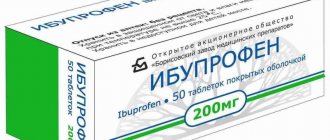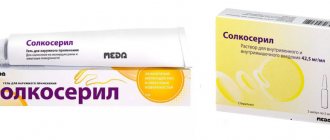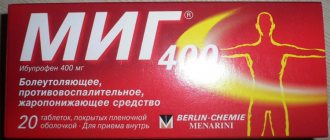For the treatment of moderate or mild hypertensive syndrome, the tablet drug Lerkamen, which belongs to the group of calcium channel blockers, is often used.
The active substance of this drug (lercanidipine) is quickly absorbed into the blood and retains its therapeutic effect throughout the day.
By regularly taking the medication, hypertensive patients can reduce high blood pressure and, thereby, improve their well-being. Despite all the benefits, antihypertensive medicine has contraindications and in some cases causes negative reactions in the body. Patients suffering from hypertension need to be aware of the side effects of Lerkamen in order to prevent complications from developing during treatment.
Composition and release form of the drug
Lerkamen is a long-acting drug, it is prescribed for various pathologies of blood vessels and the heart. In its structure, it is a representative of calcium antagonists that affect the functioning of the heart muscle.
Features of the action of calcium channel blockers
Lerkamen is produced in the form of tablets, with a basic chemical. the composition of the main substance is lercanidipine hydrochloride (lercanidipine, lat.) in a volume of 10 or 20 milligrams. Lercanidipine is the international nonproprietary name (INN) of Lerkamen tablets.
Germany - country - AG/Menarini Group - manufacturing company
Lerkamen 10
Lerkamen 10 is a circle-shaped tablet, the shell and the break point of which are colored light yellow, with a line on one of the edges.
Chem. tablet composition:
| Component name | Quantity | Characteristic |
| Lercanidipine hydrochloride | 10 mg. | Active component |
| Lactose monohydrate | 30 mg. | Auxiliary component |
| Sodium carboxymethyl starch type A | 15.5 mg. | Auxiliary component |
| Microcrystalline cellulose | 39 mg. | Auxiliary component |
| Povidone K30 | 4.5 mg. | Auxiliary component |
Chem. shell composition:
| Component name | Quantity |
| Hypromellose | 1.913 mg. |
| Titanium dioxide | 0.6 mg. |
| Iron oxide | 0.037 mg. |
| Macrogol | 0.3 mg. |
Video on the topic:
Lerkamen 20
The number 20 on the package means that the active ingredient is present in an amount of 20 mg per tablet.
It differs from Lerkamen 10 in the color of the shell - in Lerkamen 20 it is painted red-pink, but the color of the fracture has no differences - it is light yellow. These tablets are also round in shape and have a line on one side.
The amount of chemical substances in the Lerkamen 20 tablet itself and in its shell, respectively, twice as large as Lerkamen 10 in composition.
Analogues of the drug
The drug has some analogues that are not inferior to Lerkamen in their effectiveness:
“Vero-Amlodipine,” a Russian analogue, is used for various pathologies of blood vessels and the heart. Reaches maximum concentration in the blood after 2 hours, the effect continues for 24 hours, “Kordafen” - produced in Poland. The main active element is nifedipine. Effective for hypertension and other cardiac pathologies, use only as prescribed by a doctor, should be taken 3-4 times a day, a more precise dose will be indicated by a cardiologist, “Amlodipharm” - the tablet form of the drug helps to expand the lumen of blood vessels, reduces the load on the myocardium. Cannot be used under 18 years of age, during pregnancy, with individual lactose intolerance, “Amlorus”, the active ingredient is amlodipine, the maximum dosage should not exceed 10 mg per day, “Amlovas” is an Indian medicine that is used for various heart disease
Contraindicated in case of allergic reactions to the components, it should be taken with caution while carrying a child, “Kalchek” is also an Indian drug, 5 mg capsules, “Amlotop” is a high-quality analogue, the main component is amlodipine. Dose of tablets 5, 10 mg
It can be used as the main method of treatment or in combination with other medications.
“Lerkamen” is a drug that is sold strictly according to a prescription and is a well-tolerated drug with a prolonged antihypertensive effect.
Action of the medicine
The mechanism of action of Lerkamen tablets is explained by the effect of its active and auxiliary components on the human body and its cardiovascular system.
Providing a gradual and smooth antihypertensive effect
The active element of the drug, lercanidipine hydrochloride, selectively blocks channels that are sensitive to a substance such as calcium. It has an antihypertensive effect on smooth muscle vascular walls, which reduces the overall obstruction of the entire vascular system to the flow of blood ejected by the heart.
This helps to reduce the tone of large arteries and increase the lumen of the coronary arteries. Over time, vasodilation develops, which reduces the likelihood of a sharp decrease in circulating blood volume and the likelihood of an increase in heart rate (tachycardia).
Pharmacological properties of Lercanidipine:
| Absorption into blood and plasma | Smoothness coefficient of antihypertensive effect | Time to reach maximum concentration | Plasma half-life | Routes of elimination | Exposure time |
| Over 90% | 74% | From 30 to 150 min. | About 10 o'clock | Gastrointestinal tract - 56% Kidneys - 44% | 24 hours |
pharmachologic effect
The medical drug Lerkamen, being an antagonist of Ca from the dihydropyridine group, suppresses the influx of calcium through the membranes into the cells of the heart and smooth muscles. Lercanidipine hydrochloride relaxes the smooth muscle structures of blood vessels, thereby reducing total peripheral resistance. Due to the selective effect on the vascular walls, there is no negative inotropic effect. When administered orally, vasodilation develops gradually, so the risk of acute arterial hypotension with reflex tachycardia is minimal.
After oral administration of a single dose, the medication is quickly absorbed from the digestive tract and enters the bloodstream. Lerkamen reaches its maximum concentration in blood plasma after 2–3 hours. The therapeutic effect lasts for 24 hours. The bioavailability rate is 98%, the half-life is 8–10 hours. The drug is metabolized in the liver and excreted by the kidneys in the urine.
When is the drug contraindicated?
Taking into account the individual characteristics of the body, state of health and age, there are a number of contraindications to its use:
- Pregnancy.
- Lactation.
- Decompensated myocardial dysfunction.
- Acute coronary syndrome.
- Acute myocardial infarction.
- Sinus node dysfunction.
- Hypolactasia.
- Ischemic disease.
- Acute liver and kidney diseases.
- Children under 18 years old .
- Intolerance to elements that are part of the medicine.
Photos of some conditions:
Acute coronary syndrome
Myocardial infarction
Hypolactasia
Ischemia
Sinus node dysfunction
Contraindications for use
As the instructions for use indicate, Lerkamen is contraindicated for use by patients who have the following diseases, physiological conditions, and factors:
- Increased sensitivity to any of the components included in the drug.
- Childbearing age in women not using reliable contraception.
- Adolescence and childhood.
- Lactation period.
- Lactase deficiency.
- Pregnancy period.
- Lactose intolerance.
- Use with citrus juices.
- Therapy with cyclosporines.
- Moderate to severe renal failure.
- Severe renal failure.
- A history of a heart attack in the last 2 months.
- Vascular obstruction.
- Heart rhythm disturbances.
- Heart failure in the absence of quality treatment.
Use with caution in elderly patients and those suffering from coronary heart disease is allowed.
Let's take a closer look at the instructions for using Lerkamen.
Instructions for use of Lerkamen and dosage
The medicine leaflet describes in detail how to take the medicine.
The daily dose of Lerkamen corresponds to 1 tablet (10 mg.). The dose of the medicine can be gradually increased to 2 tablets (20 mg) per day, but not earlier than two weeks after the start of treatment.
It should be taken in the morning, without chewing, a maximum of 15 minutes before eating, with a significant amount of water.
It is contraindicated to drink grapefruit juice, as it reduces the rate of metabolism, which may lead to an increase in antihypertensive effects.
Overdose
In case of an overdose, may occur :
- Instant reduction in blood pressure.
- Violation of sinus rhythm.
- State of severe hypoxia.
- Drowsiness.
- Nausea.
- Fainting.
If one of these symptoms occurs when using the drug Lerkamen, you should urgently contact a specialist.
Comparison of safety and tolerability of the drug with other calcium antagonists
In case of poisoning of the body, gastric lavage, laxatives, and enterosorbents are prescribed. In case of severe intoxication, the patient is prescribed atropine, catecholamines, and diuretics.
Features of application
Due to a number of contraindications and side effects, Lerkamen should be taken based on age, existing diseases and the general clinical picture of the condition of the whole organism.
In childhood
There is no experience in treating children with Lerkamen in pediatric practice . Based on this, its use is limited to those under 18 years of age.
Elderly people
The effectiveness of the drug compared to other calcium channel blockers
For people aged 50+, 60+, etc., Lerkamen should be taken under the close supervision of a physician, based on the therapeutic effect.
During pregnancy and lactation
There are no results from the use of Lerkamen tablets by pregnant women in the treatment of hypertension.
Lercanidipine, the main component of Lerkamen, has a high lipophilicity, which may result in the penetration of the substance into breast milk.
Based on the above, the drug is not recommended during pregnancy and breastfeeding.
If the functioning of the liver or kidneys is impaired
If the nature of the disease manifests itself in a mild and moderate form of severity, then treatment with Lerkamen can begin with a daily dose of 10 mg, gradually increasing to 20 mg. If the form of the disease is severe, then taking the drug is undesirable .
Possible side effects of Lerkamen
Pay attention to the peculiarities of Lerkamen in the manifestation of side effects.
The medicine has a number of possible side effects:
| Organ systems | Impact of Lerkamen |
| Nervous system | Adynamia. Headache. Sleep disorder. |
| Gastrointestinal tract | Nausea. Vomit. Digestive disorder. |
| The cardiovascular system | Reduced blood pressure. Angina pectoris. Tachycardia. Cardiopalmus. |
| Leather | Rashes |
| Kidneys and urinary system | Increased urine production |
| Musculoskeletal system | Myalgia |
| General violations | Swelling. Allergy. |
Side effects
The use of the drug affects the nervous, cardiovascular and digestive systems. There are frequent cases of migraines, drowsiness, dizziness, fatigue, and disruption of the usual rest regime. The patient has problems with stool and digestion of food. Nausea, vomiting, and gastralgia appear. ALT and AST may increase. The patient feels pain in the chest area, the pulse rate increases, angina pectoris and arterial hypotension may appear. The patient may experience swelling of the face, dermatological problems due to an allergic skin reaction and urination problems.
Medication overdose
A large dose of medication can cause you to feel unwell.
In case of an overdose of the medication, the patient should take a horizontal position, drink a large amount of liquid and apply a sorbent. Next you need to call an ambulance. Doctors will perform gastric lavage and stabilization of blood pressure if necessary. The patient may experience nausea, vomiting, body aches and drowsiness. The face may become pale and have a sickly appearance.
Interaction with other drugs
When treating with Lerkamen, adjustments of the following medications will be required:
- Antidepressants.
- Histamine receptor blockers (Cimetidine).
- Anticonvulsants (Phenytoin, Carbamazepine).
- Cardiotonic and antiarrhythmic drugs (Digoxin).
- Lipid-lowering drugs (Simvastatin) - an interval of 10 hours between doses.
Rational combinations of drugs with antihypertensive effect
Lerkamen tablets are recommended for use in combination with the following groups of drugs:
- Beta blockers.
- Diuretics.
- ACE inhibitors.
Video on the topic
All existing groups of drugs for high blood pressure in the medical classification:
Lerkamen, sold strictly by prescription, is a well-tolerated drug with a prolonged antihypertensive effect that has proven its effectiveness and is therefore often used in therapy.
The information on the MyMedNews.ru website is for reference and general information, collected from publicly available sources and cannot serve as a basis for making a decision on the use of medications in the course of treatment.
MyMedNews.ru
And we also have
Is domestic or imported better? Comparison of the drug Amlodipine from different manufacturers
Analogues of Lerkamen
We list the main analogues, similar in composition to Lerkamen tablets:
- Lercanidipine-S3 (Russia).
- Lacipil (UK).
- Kapidin (Bulgaria/Czech Republic).
- Amlodipine (Russia), etc.
Photos of medicines:
Lacipil
Capidin
Amlodipine
Lercanidipine-S3
Lerkamen Duo tablets are not an analogue of Lerkamen. The main difference is that Lerkamen Duo contains two active ingredients - lercanidipine hydrochloride and enalapril maleate.
Which is better: Zanidip, Amlodipine or Lerkamen?
There are a number of drugs similar to Lerkamen on the pharmacy market. How to figure out which analogue to choose - amlodipine or what is better, safer, cheaper?
Here are the comparative characteristics in the table:
| Name of the drug | Time of onset of action, hour | Duration of action of the drug, hour | Differences in contraindications | Price |
| Zanidip | 5-7 | 24 | Similar to Lerkamen | From 300 to 850 rub. |
| Amlodipine | 3 | 24 | Can be used with caution in renal and hepatic insufficiency | From 90 rub. |
| Lerkamen | 6 | 24 | Not recommended for use in severe renal and liver failure | From 405 to 1,250 rubles. |
Useful video:
List of contraindications
According to the instructions, Lerkamen should not be taken if the patient has the following problems and diseases:
- unstable angina;
- heart failure;
- severe obstruction of the vessels through which blood flows from the left ventricle of the heart;
- severe liver failure;
- myocardial infarction suffered less than a month ago;
- renal failure with CC less than 30 ml/min.
In addition, the drug should strictly not be used by persons under 18 years of age, pregnant, lactating women, people taking cyclosprorines, Ketoconazole, Ritonavir, Erythromycin, Itraconazole, Troleandomycin, and patients with lactose deficiency, lactase intolerance or high sensitivity to dihydropyridine derivatives .
Also, doctors do not recommend drinking Lerkamen to women of childbearing age who are planning a pregnancy or do not use reliable contraception. Studies were conducted on rats, which showed that the active substance has a teratogenic effect.
There is a list of conditions in which the drug is taken with caution:
- elderly age;
- weakness of the sinus node without the use of a pacemaker;
- left ventricular dysfunction;
- mild, moderate severity of renal, liver failure;
- IBS.
Reviews from cardiologists
Ignatiev Pavel Aleksandrovich, cardiologist with 20 years of experience: I recommend Lerkamen to my patients with extreme caution, first I prescribe it in small doses and observe the body’s reaction. The tablets have excellent pharmacological properties, but they have a lot of side effects.”
Victoria Vladimirovna Sergeeva, cardiologist: “Lerkamen tablets really improve the clinical condition of patients and normalize blood pressure. True, sometimes it is necessary to cancel it, since complications often arise in patients. Under no circumstances should you take this drug without consulting a specialist!”
Patient reviews about the drug
Marina Vladimirovna, 48 years old: “I take the drug with a dosage of 10 mg. already 5 months. My blood pressure problems are gone and I feel great. But my friend, the same age, stopped taking it after a week - severe swelling and attacks of tachycardia appeared.”
Dmitry Ivanovich, 37 years old: “With my high weight, I constantly had problems with blood pressure, medications did not really help. On the Internet for honey. I read reviews from cardiologists about Lerkamen tablets on the forum, consulted with my doctor, and started taking them. At first I took Lerkamen 10 mg, then, seeing that the condition had improved and there were no side effects, the doctor increased the dose to 20 mg. per day. Now “Lerkamen” is my favorite drug for blood pressure.”
Indications and contraindications
The manufacturer produces Lerkamen as a blood pressure medication for mild to moderate hypertension. Contraindications for use are the following factors:
- presence of heart failure;
- period of pregnancy and lactation;
- allergy to the components of the product or individual intolerance;
- left ventricular vascular obstruction;
- angina pectoris (unstable form);
- acute stage myocardial infarction;
- weakness of the sinus node.
It is better to take medication only after consultation with the attending doctor who knows the full picture of the patient’s illness. Medical studies of the effect of the drug on children and adolescents under 18 years of age have not been carried out. As a result, the drug is prohibited for use in this group of patients. People whose work requires concentration or when driving should be careful when using Lerkamen.










